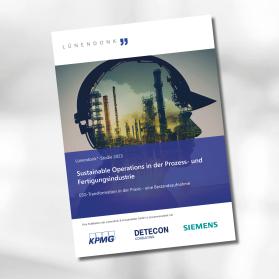By using digital technologies, companies can increase their sustainability and positively impact the sustainable development agenda up to 2030. In an interview with Dr. Tim Krüger and Dr. Rainer Weidmann, Luis Neves talks about the goal and vision of the Global Enabling Sustainability Initiative (GeSI) and how they - together with members and partners - are using digital solutions to drive global transformation towards a smarter and more sustainable world in 2030.
Detecon: Part of the mission of GeSI is to be a globally recognized thought leader and a proactive driver of the sustainability agenda. What has GeSI achieved this year that contributes to this mission and what are you currently working on?
Neves: As an organization we try to get ahead of the curve. We look very much into the future and try to understand what kind of role digital technologies will play and what the benefits and impacts of those developments will be. So, we have been working in that direction and being publishing thought leadership research like the “SMART Series” of reports which portray the relevant role of digital technologies for sustainable development. Following these reports we published last year a new piece of research called “Digital with Purpose”. This report investigated the 17 Sustainable Development Goals (SDG) and its 169 targets to understand how digital technologies can positively impact the SDG Agenda. Additionally, we took the negative impacts into account and tried to work out the potential challenges these technologies could face in the future as they are developing very fast.
In the report we made four commitments and we now ask all organizations and individuals to join us. Those four commitments are:
- to recommit to the 2030 Agenda,
- to commit to climate change,
- to embrace the principles of transparency and collaboration, and
- to understand more of digital technologies to support these commitments.
On one side we are working on the positive impacts the new technologies will have on the SDGs. On the other side, we are looking into the externalities, which are: circular economy, cyber security and privacy, supply chain, digital inclusion, business continuity and of course, climate change.
We are currently working together in developing the framework standard for our vision as to where the digital industry should be in 2030. We designed a ladder process whereby the companies that commit to the process must show progress over the years. Companies that want to be part of Digital with Purpose must have ambition to progress. We have established an independent standard board for this framework led by the Cambridge Institute for Sustainability Leadership, a globally influential Institute developing leadership and solutions for a sustainable economy. We have the Leads of each one of our working areas, as well as an external advisory panel that will advise and ensure transparency throughout.
We are designing a very ambitious and unique framework, which is aimed at driving business value and innovation through a sustainable mindset. Companies that want to be credible and transparent need to also address the externalities that can stem from such aspirations. This is our key project transitioning from last year to this year and this will be our flagship project. We expect to finalize this framework standard by the end of this year and next year, we plan to issue the very first report which will be ranking companies in relation to our standard.
Do companies participating in your project have to get net zero by 2030? The Deutsche Telekom is aiming to achieve carbon neutrality by that time. Can you explain the difference?
Companies have two options: going with carbon neutrality by buying certificates or achieving a net zero objective. I think that we all agree that leadership in Climate Change means a Net Zero ambition by 2030 – that is what Microsoft, Sky and Google among others have announced. And by the way: ZERO is ZERO. Buying certificates is not the same as Net Zero, right? Buying certificates and claiming carbon neutrality by whatever year is not adequately addressing the climate change challenge the world is facing. I do understand that a net zero strategy approach is difficult. But honestly, “easy things everyone can do”. Only special people or companies can do the difficult things! And one needs to say that the Digital Industry is a very wealthy industry with capacity and responsibility to lead on the Net Zero Purpose approach. It would add credibility, make a positive impact and contribute to a more sustainable world. And it would be making itself a favor as climate change impacts telecommunications infrastructures.
Which are the most important fields of activities today for ICT companies to become more sustainable?
Our industry has never faced so many challenges than it does today. If you go back ten years, the two main concerns were the supply chain and the issue around the conflict minerals. Today, a company that wants to be sustainable needs to look to a much bigger range of issues. Companies need to pay a lot more attention to circular economy, e.g. how they manage or recover electronic waste, and what kind of programs they need to put in place to make sure that they are sustainable companies. It is a challenging area that requires a lot of engagement as well as an understanding of the business opportunities on how to implement a good circular economy program.
Privacy and security are also important here, the ethical dimension of AI and its impact need to be understood and companies need to protect individual rights and assure being trustworthy.
Besides the huge area of climate change, there are these two components, both equally important: on one side companies need to reduce their own emissions but also extremely important is that digital companies need to harness the enabling potential of technology. If companies understand how their technology can be of value to sectors like energy, agriculture, logistics, health, mobility or education, they can generate better outcomes and greater business value. The enabling capacity of technology should be a fundamental piece of any sustainability program for any company. That is why in the Digital with Purpose report’s race to the top concept is extremely important. It is about telling the companies that they have a great opportunity and can derive business value through sustainability. This is something CEOs should start seeing as a great opportunity area. It is important that companies become more disruptive and think outside the box, and harness new opportunities and thereby generate business value through an area that is untapped and that is a huge source of revenue for any company these days.
The Digital with Purpose report concluded that the ICT sector has a critical role to play in enabling progress in achieving the SDGs. It will contribute an estimated 20 percent of all progress annum up to 2030, contributing an additional €2.3 trillion a year to the global economy, increasing ICT sector employment by over 45 percent to nearly 80 million, and increasing R&D by over 50 percent to €378 billion. The sector is expected to enable economic growth of between 2.5 and 4 times in the broader economy, reaching €10 trillion by 2030. So, I wonder myself what are companies waiting for?
What do you think about data centers? Can they also play a role in reducing energy consumption?
Definitely. We have seen huge improvements in the data center area. ICT companies have been investing millions of Euros in making their data centers more efficient. Huge investments have been made in data centers powered by green energy. In Europe, many companies, together with the European Commission, developed a data center code of conduct committing to make data centers more efficient, greener, and therefore more sustainable. Many companies implement data centers consolidation programs, thereby closing down inefficient data centers infrastructures. As the industry grows, so too will the demand for data storage capabilities, so there is much to be done. I am therefore convinced that the ICT industry will continue to strive to make data centers more efficient and greener.
Do you see Green IT as a competitive advantage for companies?
In our SMARTer2030 report from 2015 we looked at the types of efficiencies ICTs can generate, when applied to different sectors, e.g. agriculture, logistics, energy, health, education, or mobility. The report shows that in a business as usual environment the enabling impact of digital technologies was 20% of the overall global emissions. The business value that we calculated was 11 trillion USD. And this is the green side of IT.
If companies really focused on designing and innovating for sustainability and a greener future, this value could be 4 to 5 times bigger than we have calculated. So yes, I do think that Green IT is a great opportunity, but what I have yet to see is a strategic approach to Green IT. In our digital world, there are lots of solutions that could be identified as green solutions, but companies have not yet been able to fully understand and measure the benefits or sell them in a transparent and simple manner to the customers. It does not make sense to say a product is green just because its emissions or impacts are compensated by certificates. Along with a product emission, there are additional issues such as in the supply chain, child labor issues or environmental impacts. Communicating a green product means taking into consideration all the relevant sustainability impacts. I would not like to see our industry being labelled as doing “greenwashing”. Our industry has all the conditions to lead when identifying Green IT products and solutions. Unless we are fully transparent and serious, we will never move the needle in the right direction.
So how do you convince companies and CEOs that sustainability initiatives are worth the investment?
That's a very difficult question. CEOs have a very difficult and challenging job. Though it is my perception that most CEOs have not been paying enough attention to sustainability. I have mentioned that the business opportunities identified from a sustainable approach could be at least of 10 trillion Euros. That is the conclusion of our latest report. So, there are a few questions: how many CEOs are aware of this? Have they or do they intend to tap into these opportunities? With the Digital with Purpose Movement we are trying to challenge CEOs to engage in this race to the top, driven by sustainability as the right way of doing business. It is also the clever thing to do. Why? Because being a sustainable business increases reputation and shareholder value. It would be great to see CEOs moving away from the perception that sustainability is a “nice to have”. They should not be asking the question what the cost of sustainability is but instead challenge teams to show the benefit derived from sustainability.
The Digital with Purpose is an ambitious and disruptive movement. It is my hope that most, if not all, CEOs in our industry embrace it. Our industry likes to disrupt. The ambition that the Digital with Purpose Movement is setting will reward companies by generating additional business opportunities, through new business models and increased innovation. Digital with Purpose is about being the best in class in a digital world with a purpose, making money and getting this world being a better place through the deployment of disruptive technology capabilities, driving an agenda for the people, aiming at a society build on safety and trust. In a word: a sustainable world.
Which measures has GeSI established to carry out their daily business sustainably?
We have been working in two main areas of action: on the so-called compliance area we have developed different tools to help our members to address challenges they have in their respective supply chains, on climate change, on becoming more efficient, or to understand their most material issues. On the other side, we help them with thought leadership research. Our research lays out the vision, by saying where we are and where we need to be. This has been the case of the GeSI Smart reports and lately of our Digital with Purpose report, which is now becoming the Digital with Purpose movement. The DWP Movement is about two things: one is about competition between the companies on sustainability, but the other part, which is probably more important, is about the collective action of all the companies to make a collective impact.
My ambition would be that by 2030 I could say that we can impact 100% of the SDGs, not only 22% as our Digital with Purpose report concluded. That is where we are focusing our efforts right now. Working together in full collaboration will help us to achieve our ultimate goals.
To conclude the interview, can you give us some examples of the digital tools you use at GeSI?
Let me start with the GeSI Materiality report and tools. We were the first business organization in the world that developed an industry materiality report to understand the key areas any company in the digital world needed to address. We rank the areas from “value for the company” to “value for the society” and with that, the company can derive key material issues. We have been regularly updating this report and respective tools – the last update was in 2019. We are glad to see our members and many other companies using it once they do their sustainability reports.
To address companies’ supply chains challenges we developed one tool called E-TASC which is the abbreviation for “Electronics – Tool for Accountable Supply Chains”. E-TASC monitors the company’s performance in relation to their supply chain activities. If companies have nonconformities, they can start with an action plan or they can run an audit through our auditing companies. This way companies can improve their supply chain performance and address challenges like child labor, human rights violations, or environmental impacts. It is also a way to better inform stakeholders.
Finally, the Sustainability Assessment Framework (SASF). It was developed for GeSI by the Öko-Institut in Germany. This tool comprises of around 100 relevant sustainability indicators which allow companies to understand the sustainability performance of their products and services and thereby implement the actions required for improvement. The SASF can also be used for data centers as portrayed in one of our case studies.
Detecon: Thank you very much for the very interesting interview Mr. Neves!
_____________________________________
Luis Neves is the CEO of the Global Enabling Sustainability Initiative (GeSI). Prior to this Luis worked for Deutsche Telekom where he held different positions in the Sustainability Department. As from December 2008 Luis was assigned to the position of Vice President Corporate Responsibility. Effective February 2012, he was appointed to the position of Group Climate Change and Sustainability Officer. Luis represented the company in many different organizations – with GeSI being one of them, serving as its Chairman for 11 years. Now as CEO, moving to GeSI may have been different from the professional pathway Luis had planned after leaving Deutsche Telekom in 2017, but it was exactly what he yearned for as it gave more freedom to work with different companies. Prior to Deutsche Telecom Luis was with the International Telecommunications Union (ITU) in Geneva and spent 25 years at Portugal Telecom while in Portugal.








